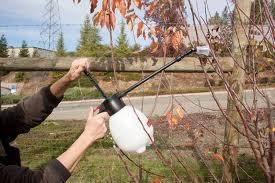Spraying before the trees bloom is important because copper is toxic to bees and other pollinators, and horticultural oil will smother them. For some diseases, however, you will have to spray while the tree is in bloom. Fire blight and brown rot are both examples. In this case, it is best to limit your spray to hours of the day when foraging insects are most likely to have returned home.
There are a number of reasons to spray some fruit trees with copper and oil. While the copper acts as a general fungicide, helping to prevent everything from peach leaf curl, to brown rot, to rust, to fire blight, oil serves as a spreader-sticker that also kills overwintering insects like wooly apple aphids.
Not every fruit tree should be sprayed with copper and horticultural oil, and trees that may benefit from spraying in one climate, don’t need to be sprayed in others. Persimmons, pomegranates, mulberries, and citrus are examples of trees that, at least in our San Francisco Bay Area climate, don’t need to be sprayed with copper and horticultural oil. That being said, peaches, nectarines, plums, grapes, pears, and apples can all benefit from a dormant spray to help fight off fungal infections carried by the rain and overwintering insects.
Keep in mind that, although copper is used by organic growers, it is a heavy metal and will ultimately end up in your soil. Toxic build-ups are possible over time.
Spraying the treesSpray on a dry day when the copper won’t be washed off by rain or diluted by fog for at least a few hours (a few days is preferable). Mix up the liquid copper and horticultural oil in the sprayer, making sure to follow the directions carefully for both. In my case, Kelly’s horticultural oil and 27.15% copper solution called for 3 tablespoons of oil and four tablespoons of copper per gallon of water. A Gilmour hose-end sprayer, available at many nurseries and hardware stores, attaches to the end of a garden hose and mixes the water with the copper and oil solution. 8 tablespoons per gallon on the peach and nectarine trees and four tablespoons per gallon on the pear trees.
Exercise cautionWhile dormant spraying is easy enough to do yourself, it’s worth exercising caution. Contact your local extension office or try to find knowledgeable nursery-folk to make certain that you are using the proper proportions and only spraying trees that really need it. A visit to the local hardware store garden section conveys the dizzying number of chemicals available to anyone who feels like paying the price and why it imperils our natural environment.
This article was compiled from an original post on the gardening blog Overall Gardener by Sarah Phoenix.
Find the original article here: http://www.overallgardener.com/tis-the-season-for-dormant-fruit-tree-sprays/.


